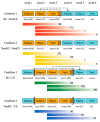Syntactic Comprehension of Relative Clauses and Center Embedding Using Pseudowords
- PMID: 32244525
- PMCID: PMC7226570
- DOI: 10.3390/brainsci10040202
Syntactic Comprehension of Relative Clauses and Center Embedding Using Pseudowords
Abstract
Relative clause (RC) formation and center embedding (CE) are two primary syntactic operations fundamental for creating and understanding complex sentences. Ample evidence from previous cross-linguistic studies has revealed several similarities and differences between RC and CE. However, it is not easy to investigate the effect of pure syntactic constraints for RC and CE without the interference of semantic and pragmatic interactions. Here, we show how readers process CE and RC using a self-paced reading task in Korean. More interestingly, we adopted a novel self-paced pseudoword reading task to exploit syntactic operations of the RC and CE, eliminating the semantic and pragmatic interference in sentence comprehension. Our results showed that the main effects of RC and CE conform to previous studies. Furthermore, we found a facilitation effect of sentence comprehension when we combined an RC and CE in a complex sentence. Our study provides a valuable insight into how the purely syntactic processing of RC and CE assists comprehension of complex sentences.
Keywords: embedding; merge; self-paced reading; syntactic hierarchy.
Conflict of interest statement
The authors declare no conflict of interest.
Figures





Similar articles
-
Lexico-syntactic interactions during the processing of temporally ambiguous L2 relative clauses: An eye-tracking study with intermediate and advanced Portuguese-English bilinguals.PLoS One. 2019 May 29;14(5):e0216779. doi: 10.1371/journal.pone.0216779. eCollection 2019. PLoS One. 2019. PMID: 31141531 Free PMC article. Clinical Trial.
-
Examining Online Syntactic Processing of Spoken Complex Sentences in Chinese Using Dual-Modal Interference Tasks.J Vis Exp. 2019 Sep 5;(151). doi: 10.3791/59660. J Vis Exp. 2019. PMID: 31545324
-
Plausibility leads to better comprehension but not syntactic adaptation: Evidence from structural disambiguation in Chinese.Q J Exp Psychol (Hove). 2025 Mar 21:17470218251332420. doi: 10.1177/17470218251332420. Online ahead of print. Q J Exp Psychol (Hove). 2025. PMID: 40116152
-
Bilingual deaf readers' use of semantic and syntactic cues in the processing of English relative clauses.Biling (Camb Engl). 2017 Nov;20(5):980-998. doi: 10.1017/S1366728916000602. Epub 2016 Jun 29. Biling (Camb Engl). 2017. PMID: 29308049 Free PMC article.
-
Neural mechanisms of language comprehension: challenges to syntax.Brain Res. 2007 May 18;1146:23-49. doi: 10.1016/j.brainres.2006.12.063. Epub 2006 Dec 23. Brain Res. 2007. PMID: 17400197 Review.
References
-
- Chomsky N. Lectures on Government and Binding: The Pisa Lectures. Walter de Gruyter; Berlin, Germany: 1993.
-
- Kayne R.S. The Antisymmetry of Syntax. MIT Press; Cambridge, MA, USA: 1994.
-
- Sag I.A. English relative clause constructions. J. Linguist. 1997;33:431–483. doi: 10.1017/S002222679700652X. - DOI
-
- Chomsky N. The Minimalist Program. MIT Press; Cambridge, MA, USA: 2014.
Grants and funding
LinkOut - more resources
Full Text Sources

